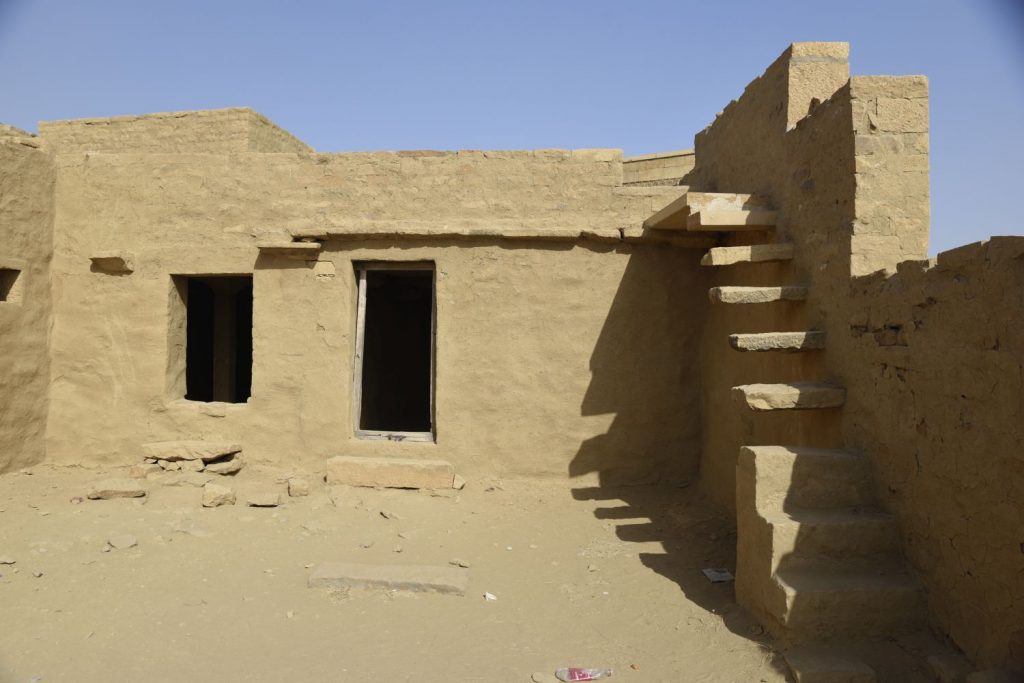
Jaisalmer is a gateway to the Thar Desert, which extends throughout much of Rajasthan and into a few neighbouring Indian states.
The desert also reaches into nearby Pakistan, extending to the more fertile Indus Valley.
This location has given the old fort city of Jaisalmer two key industries: tourism and the military.
Tourists can imagine themselves in the Arabian Nights, even if the geography is a bit off and the ever-present motorcycles destroy the illusion. For many, it’s their first time to ride a camel. (I had only ever had a short ride on one).
With only a narrow strip of desert separating India and Pakistan, the military is very present in this region, even if tensions have quieted between the two adversaries and most of the conflict has been in Kashmir.
After arriving late the previous night, I set out early in the morning to explore the fort as the red sun rose through hazy skies. Though not nearly as high as Jodhpur’s fort, Jaisalmer’s fort is still perched atop sandstone cliffs and is a bit of a climb.
Also different is that Jaisalmer’s fort is still lived in. There’s a maze of streets among which are houses, tourist-oriented craft sellers, hotels and Hindu and Jain temples. Despite the commercialism, there was no serious hard sell or aggression and the streets had a lot of colour and atmosphere.
Nonetheless, there are worries that demands for water by local residents and tourists are putting a strain on the structure of the fort and its inadequate sewage network. Some are calling for people to be moved out, while some tourist guidebooks advise people not to stay in hotels in the fort. (Mine was outside and below the fort, but within easy walking distance).
There are numerous elaborate havelis, older palatial residences, especially to the north of the fort. I visited a major one, Patwa-ki-Havel.
There I met an Indo-Canadian couple, from Edmonton, who like to vacation in Osoyoos and were impressed that I live there. The husband didn’t bother to climb to the upper floors of the haveli, saying they are all the same, with the same floor plan around a courtyard.
At the hotel I had booked a camel outing leaving at 3 p.m. and returning that night. The trip included visits to a couple local villages and a ghost town, a camel ride in the sand dunes to watch the sunset and then entertainment of music, traditional dances and dinner at a nearby camp.
I got a reduced rate on the trip by agreeing to go with another tourist, who was doing the same trip except staying the night at the camp in a luxury tent equipped with large bed, separate bathroom with toilet and plumbing and hot water. If I had longer, I might have been tempted to do the overnight, or better yet take a trip that camped in the desert. But my schedule was tight and time limited.
The other tourist turned out to be Yogesh, an information technology manager originally from Delhi, but now working in Jaipur. He is responsible for getting all the post offices in Rajasthan onto a computer system that will facilitate a change that will see the post offices also act as banks. It’s a challenge, especially for many of the smaller post offices that tend to be more paper-driven and wary of computer technology.
Yogesh speaks excellent English and is friendly with a good sense of humour, so it was great to have him along – especially when he could translate and explain things to me. This was lucky as our guide and driver spoke very little English.
The village visits were a little contrived. One woman showed us her home and served us tea. She is obviously used regularly for these visits. I asked her if I could photograph her, but she declined – as Yogesh said, it is not their custom. This is a pity because the clothing the Rajasthani women wear is very colourful and they are very photogenic. I did get her two children to pose rigidly until I did something to make them laugh and they became more natural.
The ghost town was built with stone and the guide said it was hundreds of years old. I didn’t really get the story, so I will try to look it up when I can figure out exactly which one it was.
Our camel man, Piru Khan, was only in his early 20s, but I guessed he was a decade or two older because his face was weathered from the sun.
He only rents the camels and makes very little money, about $40 a month, he said, though I expect he makes more in tips. His dream is to buy his own camel and go into business for himself. He asked us for seed money, but the best we could do, Yogesh told him, would be to post his information on social media if anyone wants to give to him.
He spoke better English than our guide, and he fitted us up with two camels – Rocket and Lucky.
I got Rocket and Yogesh drew the short straw and got Lucky. Rocket was the leader. Lucky was painted with ridiculous black spots that either made him look like a leopard or like he had measles.
Riding a camel is different from riding a horse. For one thing, you are a lot higher up, sitting well above the camel’s head. On the other hand, the camel squats down on the ground when you mount and dismount so it’s actually easier to get on, though you do have to hold on and keep your balance when the camel stands up and when it squats.
We never had the camels going at much of a speed beyond a slow walk except for one short moment at the end when we trotted a few paces. But the ride seemed gentler than a horse – you sway on the camel rather than bumping up and down or posting on a horse.
We soon climbed from scrubby flat desert into the dunes and I tried to imagine myself as Lawrence of Arabia. The illusion was shattered when children came running out from behind a dune to offer bottles of pop for sale or to sing and perform for rupees. Two little girls did a version of Frere Jacques, completely mangling the words and then going off onto a more Rajasthani rhythm while a boy provided percussion.
“The remix version,” Yogesh joked.
As we continued through the dunes, the sun got lower and lower, though the actual sunset remained about an hour away. Now we began seeing other groups on camels and then jeeps, which raced up and down the dunes, full of Indian tourists, sometimes getting stuck. They often drove very near to the camels. Although the jeeps were labeled as jeep safari companies, the man at the hotel claimed they aren’t actually allowed on the dunes. Obviously this isn’t enforced.
I have heard that some areas around Sam have a carnival atmosphere with all the tourist activity at sunset. This wasn’t as bad as that, but it wasn’t a real wilderness camel trek, which requires a longer trip to a more remote location.
I did get some good photos of camels in the sand, hoping the fine sand wouldn’t damage my camera equipment. Fortunately it wasn’t blowing.
Yogesh suggested after a while that we didn’t need to stay to see the actual sunset, but I said I would like to stay until the sun was lower and more orange. So we waited another half hour or so while Yogesh, Piru and some other men chatted, the camels rested, and I looked around for photos.
The camels were on the top of one dune and I found another high dune nearby from where I could see the setting sun behind the camels. When the sun was optimal, I asked Piru to lead our two camels along the ridge.
Just as I was lining up my shot, an infernal jeep roared up and promptly got stuck right next to the camels and in front of my shot. As the sun got lower, I got more and more impatient. Fortunately they got unstuck soon, Piru continued with the camels and I got a few shots of the silhouetted camels with the sun behind them. Yes, it’s a cliché, but I wanted that shot and got it.
Very near there we were met by our guide, who took us nearby to the camp for the music, dance and food.
Although there were a couple of Chinese tourists at the start, I was the only foreigner as the night wore on. At the very end, the dancers invited everyone up to dance together. Many Indians asked me to dance with their group. Often in India, as a foreigner I am a novelty. Yogesh found it funny.
Yogesh and I met a driver of a tourist mini-bus, Ajay, when we were at the ghost town. Ajay was going to Bikaner the next day and said he had two available seats. I had an overnight train booked for the following night, but only a seat, so had considered otherwise taking a bus.
The ride with Ajay sounded like a good alternative, so we agreed to meet the next morning.


